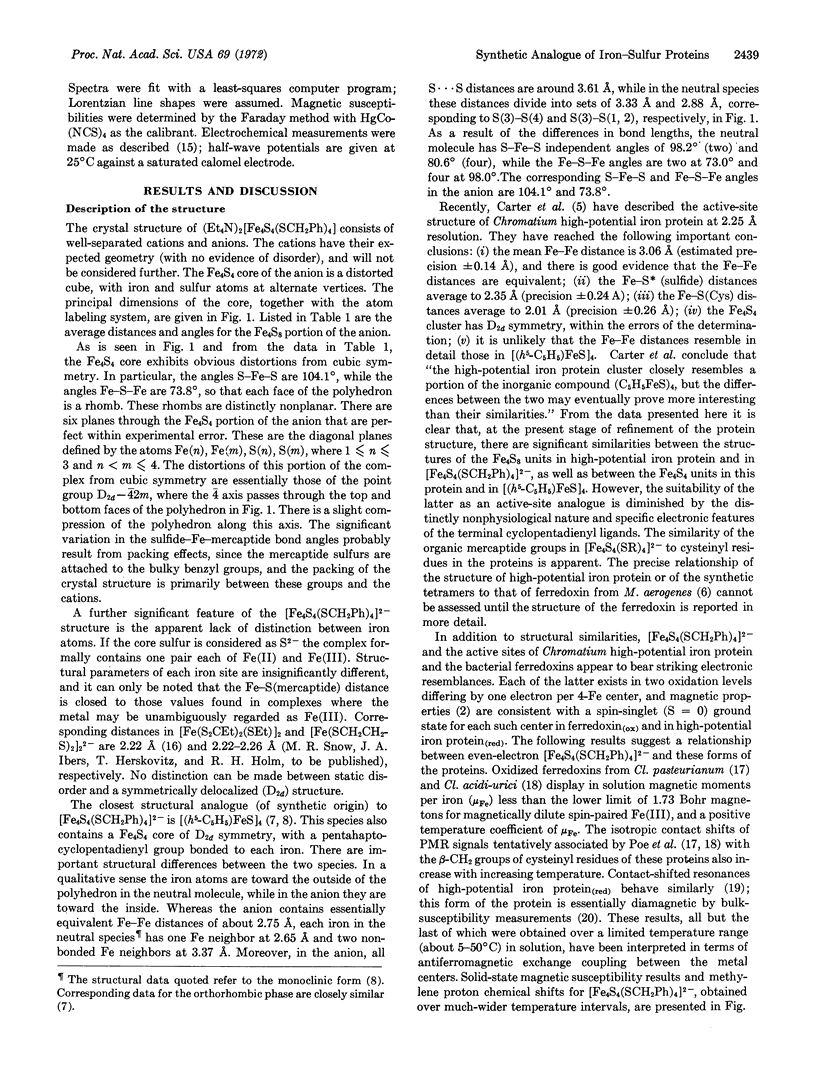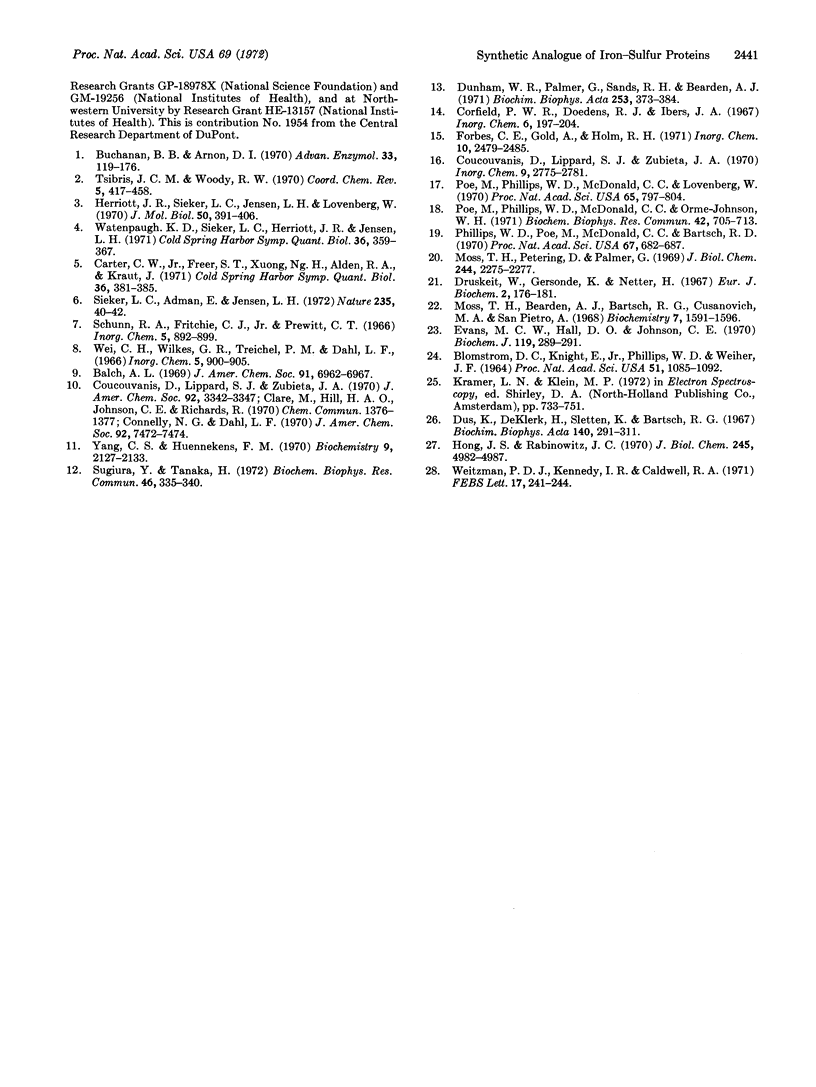Abstract
The compound (Et4N)2[Fe4S4(SCH2Ph)4] has been prepared and its structure determined by x-ray diffraction. The Fe4S4 core of the anion possesses a configuration of D2d symmetry that is closely related to the Fe4S4 active-site structures of the high-potential iron protein from Chromatium and the ferredoxin from Micrococcus aerogenes. Electronic properties of the tetrameric anion have been partially characterized by measurement of proton magnetic resonance, Mössbauer, photoelectron, and electronic spectra, and magnetic susceptibility. Comparison of corresponding properties of [Fe4S4(SCH2Ph)4]2- and the proteins implies that the oxidation levels of the synthetic tetramer, the reduced form of the high-potential protein, and the oxidized form of the 8-Fe ferredoxins are equivalent. The tetramer possesses the one-electron redox capacity associated with the 4-Fe centers of the ferredoxins. The structural and collective electronic features of [Fe4S4(SCH2Ph)4]2- reveal it to be the first well-defined synthetic analogue of the active site of an iron-sulfur protein.
Keywords: Fe4S4 core, PMR-iron-sulfur complexes, x-ray diffraction
Full text
PDF




Selected References
These references are in PubMed. This may not be the complete list of references from this article.
- BLOMSTROM D. C., KNIGHT E., Jr, PHILLIPS W. D., WEIHER J. F. THE NATURE OF IRON IN FERREDOXIN. Proc Natl Acad Sci U S A. 1964 Jun;51:1085–1092. doi: 10.1073/pnas.51.6.1085. [DOI] [PMC free article] [PubMed] [Google Scholar]
- Buchanan B. B., Arnon D. I. Ferredoxins: chemistry and function in photosynthesis, nitrogen fixation, and fermentative metabolism. Adv Enzymol Relat Areas Mol Biol. 1970;33:119–176. doi: 10.1002/9780470122785.ch3. [DOI] [PubMed] [Google Scholar]
- Carter C. W., Jr, Freer S. T., Xuong N. H., Alden R. A., Kraut J. Structure of the iron-sulfur cluster in the Chromatius iron protein at 2.25 Angstrom resolution. Cold Spring Harb Symp Quant Biol. 1972;36:381–385. doi: 10.1101/sqb.1972.036.01.049. [DOI] [PubMed] [Google Scholar]
- Druskeit W., Gersonde K., Netter H. pH-abhängige magnetostatische und spektrale Eigenschaften des oxydierten Ferredoxins aus Clostridium pasteurianum. Eur J Biochem. 1967 Sep;2(2):176–181. doi: 10.1111/j.1432-1033.1967.tb00123.x. [DOI] [PubMed] [Google Scholar]
- Dunham W. R., Palmer G., Sands R. H., Bearden A. J. On the structure of the iron-sulfur complex in the two-iron ferredoxins. Biochim Biophys Acta. 1971 Dec 7;253(2):373–384. doi: 10.1016/0005-2728(71)90041-7. [DOI] [PubMed] [Google Scholar]
- Dus K., De Klerk H., Sletten K., Bartsch R. G. Chemical characterization of high potential iron proteins from Chromatium and Rhodopseudomonas gelatinosa. Biochim Biophys Acta. 1967 Jun 27;140(2):291–311. doi: 10.1016/0005-2795(67)90470-9. [DOI] [PubMed] [Google Scholar]
- Evans M. C., Hall D. O., Johnson C. E. Hyperfine structure of (57Fe) iron in the Mössbauer spectrum of the high-potential iron protein from Chromatium. Biochem J. 1970 Sep;119(2):289–291. doi: 10.1042/bj1190289. [DOI] [PMC free article] [PubMed] [Google Scholar]
- Herriott J. R., Sieker L. C., Jensen L. H., Lovenberg W. Structure of rubredoxin: an x-ray study to 2.5 A resolution. J Mol Biol. 1970 Jun 14;50(2):391–406. doi: 10.1016/0022-2836(70)90200-7. [DOI] [PubMed] [Google Scholar]
- Hong J. S., Rabinowitz J. C. Molar extinction coefficient and iron and sulfide content of clostridial ferredoxin. J Biol Chem. 1970 Oct 10;245(19):4982–4987. [PubMed] [Google Scholar]
- Moss T. H., Bearden A. J., Bartsch R. G., Cusanovich M. A., San Pietro A. Mössbauer spectroscopy of non-heme iron proteins. Biochemistry. 1968 Apr;7(4):1591–1596. doi: 10.1021/bi00844a048. [DOI] [PubMed] [Google Scholar]
- Moss T. H., Petering D., Palmer G. The magnetic susceptibility of oxidized and reduced ferredoxins from spinach and parsley and the high potential protein from Chromatium. J Biol Chem. 1969 May 10;244(9):2275–2277. [PubMed] [Google Scholar]
- Phillips W. D., Poe M., McDonald C. C., Bartsch R. G. Proton magnetic resonance studies of Chromatium high-potential iron protein. Proc Natl Acad Sci U S A. 1970 Oct;67(2):682–687. doi: 10.1073/pnas.67.2.682. [DOI] [PMC free article] [PubMed] [Google Scholar]
- Poe M., Phillips W. D., McDonald C. C., Lovenberg W. Proton magnetic resonance study of ferredoxin from Clostridium pasteurianum. Proc Natl Acad Sci U S A. 1970 Apr;65(4):797–804. doi: 10.1073/pnas.65.4.797. [DOI] [PMC free article] [PubMed] [Google Scholar]
- Poe M., Phillips W. D., McDonald C. C., Orme-Johnson W. H. PMR and magnetic susceptibility studies on Clostridium acidi-urici ferredoxin. Biochem Biophys Res Commun. 1971 Feb 19;42(4):705–713. doi: 10.1016/0006-291x(71)90545-6. [DOI] [PubMed] [Google Scholar]
- Sieker L. C., Adman E., Jensen L. H. Structure of the Fe-S complex in a bacterial ferredoxin. Nature. 1972 Jan 7;235(5332):40–42. doi: 10.1038/235040a0. [DOI] [PubMed] [Google Scholar]
- Sugiura Y., Tanaka H. Iron-sulfide chelates of some sulfur-containing peptides as model complex of non-heme iron proteins. Biochem Biophys Res Commun. 1972 Jan 31;46(2):335–340. doi: 10.1016/s0006-291x(72)80143-8. [DOI] [PubMed] [Google Scholar]
- Watenpaugh K. D., Sieker L. C., Herriott J. R., Jensen L. H. The structure of a non-heme iron protein: rubredoxin at 1.5 Angstrom resolution. Cold Spring Harb Symp Quant Biol. 1972;36:359–367. doi: 10.1101/sqb.1972.036.01.047. [DOI] [PubMed] [Google Scholar]
- Weitzman P. D.J., Kennedy I. R., Caldwell R. A. Polarographic activity and electrolytic reduction of ferredoxin. FEBS Lett. 1971 Oct 1;17(2):241–244. doi: 10.1016/0014-5793(71)80155-2. [DOI] [PubMed] [Google Scholar]
- Yang C. S., Huennekens F. M. Iron-mercaptoethanol-inorganic sulfide complex. Possible model for the chromophore of nonheme iron proteins. Biochemistry. 1970 May 12;9(10):2127–2133. doi: 10.1021/bi00812a015. [DOI] [PubMed] [Google Scholar]


